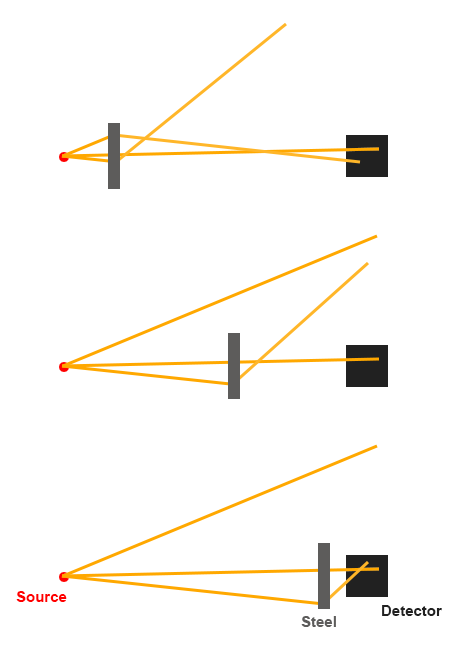Effect of the position of shielding
Gamma radiation may interact with material placed between a source of radioactivity and a detector. As a result of this shielding, some of the radiation will be absorbed, which will lead to a reduction of the count rate observed by the detector. How much radiation is being absorb depends on the mass attenuation coefficient and the amount of material in the shield. When only undisturbed radiation is being counted, the calculation is straightforward and the position of the shielding has no effect on the count rate.
However, the interaction processes may also absorb the energy of a gamma particle only partially. As a result, particles will loose energy and may be scattered. A detector which does not record a gamma spectrum but registers count rate only cannot discriminate between direct and scattered particles. Since scattering affects the direction of the gamma particles, shielding may cause gamma particles to be deflected towards or away from the detector. As a result, the position of the shielding may will an affect on chance to register a scattered gamma particle. Gamma particles that would normally miss the detector can be scattered towards or away from the detector. This effect is greatest close to the source and close to the detector. As a result, the count rate will be lower when the shielding is in the middle than when the shielding is close to either the source or the detector.
The figure below shows the effect of scattering on the observed count rate in three situations. In all situations, gamma particles from the source on the left may be registered by the detector on the right. The top and bottom figure show a particle being scattered towards the detector, increasing the count rate with respect to the situation in the middle.
|
|---|
| Figure 1: Effect of the position of the shielding in 3 situations. |
Since all scattered gamma particles lose some energy, it is possible to ignore scattered particles by setting an energy window such that only undisturbed particles are being registered. As a result, the position of the shielding no longer has any effect on the count rate. A disadvantage is that this procedure significantly reduces the registered count rate, which will lead to a lower accuracy of the measurement.

